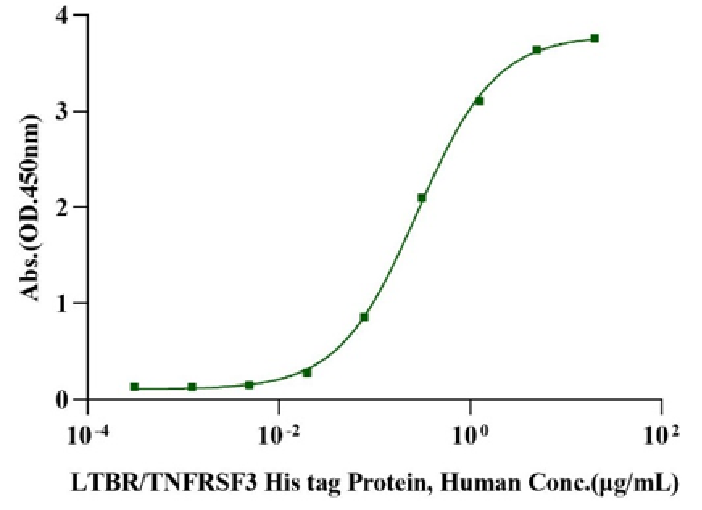Asp74-Val240, with N-terminal hIgG1 Fc
50 kDa (Reducing)
50mM Glycine, 300mM NaCl, pH9.5.
Reconstitute at 0.1-1 mg/ml according to the size in ultrapure water after rapid centrifugation.
12 months from date of receipt, lyophilized powder stored at -20 to -80℃.
·3 months, -20 to -80℃ under sterile conditions after reconstitution.
·1 week, 2 to 8℃ under sterile conditions after reconstitution.
·Please avoid repeated freeze-thaw cycles.
J Clin Invest. 2001 Dec;108(12):1771-80.
TNFSF14, also known as tumor necrosis factor ligand superfamily member 14 or LIGHT (homologous to lymphotoxins, exhibits inducible expression, and competes with HSV glycoprotein D for HVEM, a receptor expressed by T lymphocytes), is a cytokine belonging to the tumor necrosis factor (TNF) superfamily. TNFSF14 is a type II transmembrane protein that can be cleaved to produce a soluble form. It functions as a ligand for two receptors, herpes virus entry mediator (HVEM) and lymphotoxin beta receptor (LTβR), and is involved in regulating immune responses, inflammation, and lymphoid organ development. TNFSF14 has been implicated in various physiological and pathological processes, including the modulation of T cell activation, the regulation of immune cell migration, and the promotion of antitumor immunity.
Measured in a cell proliferation assay using HT-29 human colon adenocarcinoma cells), the EC50 for this effect is less than 10ng/ml.
2μg (R: reducing condition, N: non-reducing condition).
>95% as determined by RP-HPLC.
Immobilized LIGHT/TNFSF14 Protein, Human (Cat. No. UA040352) at 5.0μg/mL (100μL/well) can bind LTBR/TNFRSF3 His tag Protein, Human (Cat. No. UA010534) with EC50 of 0.25-0.31ug/mL.

Immobilized LIGHT/TNFSF14 Protein, Human (Cat. No. UA040352) at 5/mL (100μL/well) can bind LTBR/TNFRSF3 His tag Protein, Human (Cat. No. UA010534) with EC50 of 0.25-0.31 μg/mL.